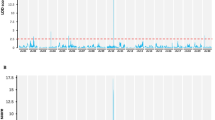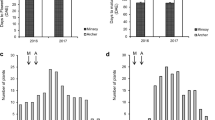Abstract
Soybean is highly sensitive to photoperiod. To improve the adaptability and productivity of soybean, it is essential to understand the molecular mechanisms regulating flowering time. To identify new flowering time QTLs, we evaluated a BC3F5 population consisting of 120 chromosome segment substitution lines (CSSLs) over 2 years under field conditions. CSSLs were derived from a cross between the cultivated soybean cultivar Jackson and the wild soybean accession JWS156-1, followed by continuous backcrossing using Jackson as the recurrent parent. Four QTLs (qFT07.1, qFT12.1, qFT12.2, and qFT19.1) were detected on three chromosomes. Of these, qFT12.1 showed the highest effect, accounting for 36.37–38.27% of the total phenotypic variation over 2 years. This QTL was further confirmed in the F7 recombinant inbred line population (n = 94) derived from the same cross (Jackson × JWS156-1). Analysis of the qFT12.1 BC3F5 residual heterozygous line RHL509 validated the allele effect of qFT12.1 and revealed that the recessive allele of qFT12.1 resulted in delayed flowering. Evaluating the qFT12.1 near-isogenic lines (NILs) under different growth conditions showed that NILs with the wild soybean genotype always showed later flowering than those with the cultivated soybean genotype. qFT12.1 was delimited to a 2703-kb interval between the markers BARCSOYSSR_12_0220 and BARCSOYSSR_12_0368 on chromosome 12. qFT12.1 may be a new flowering time gene locus in soybean.




Similar content being viewed by others
References
Benlloch R, Berbel A, Serrano-mislata A, Madueno F (2007) Floral initiation and inflorescence architecture: a comparative view. Ann Bot 100:656–676
Bernard RL (1971) Two major genes for time of flowering and maturity in soybeans. Crop Sci 11:242–244
Bonato ER, Vello NA (1999) E6, a dominant gene conditioning early flowering and maturity in soybeans. Genet Mol Biol 22:229–232
Briggs WR, Christie JM (2002) Phototropins 1 and 2: versatile plant blue-light receptors. Trends Plant Sci 7:1360–1385
Buzzell RI (1971) Inheritance of a soybean flowering response to fluorescent-daylength conditions. Can J Genet Cytol 13:703–707
Buzzell RI, Voldeng HD (1980) Inheritance of insensitivity to long daylength. Soyb Genet Newsl 7:26–29
Cober ER, Voldeng HD (2001) A new soybean maturity and photoperiod-sensitivity locus linked to E1 and T. Crop Sci 41:698–701
Cober ER, Molnar SJ, Charette M, Voldeng HD (2010) A new locus for early maturity in soybean. Crop Sci 50:524–527
Concibido VC, La Vallee B, Mclaird P, Pineda N, Meyer J, Hummel L, Yang J, Wu K, Delannay X (2003) Introgression of a quantitative trait locus for yield from Glycine soja into commercial soybean cultivars. Theor Appl Genet 106:575–582
Do TD, Chen HT, Hien VT, Hamwieh A, Yamada T, Sato T, Yan YL, Cong H, Shono M, Suenaga K, Xu DH (2016) Ncl synchronously regulates Na+, K+, and Cl– in soybean and greatly increases the grain yield in saline field conditions. Sci Rep 6:19147. https://doi.org/10.1038/srep19147
Fehr WR, Caviness CE, Burmood DT, Pennington JS (1971) Stage of development descriptions for soybean, Glycine max (L.) Merrill. Crop Sci 11:929–931
Githiri SM, Yang D, Khan NA, Xu DH, Komatsuda T, Takahashi R (2007) QTL analysis of low temperature induced browning in soybean seed coats. J Hered 98:360–366
Grandillo S, Tanksley SD (2005) Advanced backcross QTL analysis: results and perspectives. In: Mugnozza GTS, Porceddu E, Pagnotta MA (ed) Genetics and breeding for crop quality and resistance, 1rd edn. Viterbo, Italy, pp 283–290
Han YP, Li DM, Zhu D, Li HY, Li XP, Teng WL, Li WB (2012) QTL analysis of soybean seed weight across multi-genetic backgrounds and environments. Theor Appl Genet 125:671–683
Hu ZB, Zhang D, Zhang GZ, Kan GZ, Hong DL, Yu DY (2013) Association mapping of yield-related traits and SSR markers in wild soybean (Glycine soja Sieb. and Zucc.) Breed Sci 63:441–449
Jung CH, Wong CE, Singh MB, Bhalla PL (2012) Comparative genomic analysis of soybean flowering genes. PLoS One 7(6):e38250
Kong FJ, Nan HY, Cao D, Li Y, Wu FF, Wang JL, Lu SJ, Yuan XH, Cober ER, Abe J, Liu BH (2015) A new dominant gene E9 conditions early flowering and maturity in soybean. Crop Sci 54:2529–2535
Kuroda Y, Kaga A, Tomooka N, Yano H, Takada Y, Kato S, Vaughan D (2013) QTL affecting fitness of hybrids between wild and cultivated soybeans in experimental fields. Ecol Evol 3:2150–2168
Liu BH, Kanazawa A, Matsumura H, Takahashi R, Harada K, Abe J (2008) Genetic redundancy in soybean photoresponses associated with duplication of phytochrome a gene. Genetics 180:995–1007
Liu BH, Watanabe S, Uchiyama T, Kong FJ, Kanazawa A, Xia ZJ, Nagamatsu A, Arai M, Yamada T, Kitamura K, Masuta C (2010) The soybean stem growth habit gene Dt1 is an ortholog of Arabidopsis TERMINAL FLOWER1. Plant Physiol 153:198–210
Lu SJ, Zhao XH, Hu YL, Liu SL, Nan HY, Li XM, Fang C, Cao D, Shi XY, Kong LP, Su T, Zhang FG, Li SC, Wang Z, Yuan XH, Cober ER, Weller JL, Liu BH, Hou XL, Tian ZX, Kong FJ (2017) Natural variation at the soybean J locus improves adaptation to the tropics and enhances yield. Nat Genet 49:773–779
Mansur LM, Lark KG, Kross H, Oliveira A (1993) Interval mapping of quantitative trait loci for reproductive, morphological, and seed traits of soybean (Glycine max L.) Theor Appl Genet 86:907–913
McBlain BA, Bernard RL (1987) A new gene affecting the time of flowering and maturity in soybeans. J Hered 78:160–162
Meng L, Li HH, Zhang LY, Wang JK (2015) QTL IciMapping: integrated software for genetic linkage map construction and quantitative trait locus mapping in biparental populations. Crop J 3:269–283
Orf JH, Chase K, Jarvik T, Mansur LM, Cregan PB, Adler FR, Lark KG (1999) Genetics of soybean agronomic traits: I comparison of three related recombinant inbred populations. Crop Sci 39:1642–1651
Panthee DR, Pantalone VR, Saxton AM, West DR, Sams CE (2007) Quantitative trait loci for agronomic traits in soybean. Plant Breed 126:51–57
Ray JD, Hinson K, Mankono JEB, Malo MF (1995) Genetic control of a long-juvenile trait in soybean. Crop Sci 35:1001–1006
Samanfar B, Molnar SJ, Charette M, Schoenrock A, Dehne F, Golshani A, Belzile F, Cober ER (2017) Mapping and identification of a potential candidate gene for a novel maturity locus, E10, in soybean. Theor Appl Genet 130:377–390
Sebolt AM, Shoemaker RC, Diers BW (2000) Analysis of a quantitative trait locus allele from wild soybean that increases seed protein concentration in soybean. Crop Sci 40:1438–1444
Song QJ, Marek LF, Shoemaker RC, Lark KG, Concibido VC, Delannay X, Specht JE, Cregan PB (2004) A new integrated genetic linkage map of the soybean. Theor Appl Genet 109:122–128
Song QJ, Jia GF, Zhu YL, Grant D, Nelson RT, Hwang EY, Hyten DL, Cregan PB (2010) Abundance of SSR motifs and development of candidate polymorphic SSR markers (BARCSOYSSR_1.0) in soybean. Crop Sci 50:1950–1960
Tian ZX, Wang XB, Lee R, Li YH, Specht JE, Nelson RL, McClean PE, Qiu LJ, Ma JX (2010) Artificial selection for determinate growth habit in soybean. Proc Natl Acad Sci 107:8563–8568
Tuyen DD, Lal SK, Xu DH (2010) Identification of a major QTL allele from wild soybean (Glycine soja Sieb. & Zucc.) for increasing alkaline salt tolerance in soybean. Theor Appl Genet 121:229–236
Wang D, Graef GL, Procopiuk AM, Diers BW (2004) Identification of putative QTL that underlie yield in interspecific soybean backcross populations. Theor Appl Genet 108:458–467
Wang WB, He QY, Yang HY, Xiang SH, Zhao TJ, Gai JY (2013) Development of a chromosome segment substitution line population with wild soybean (Glycine soja Sieb. & Zucc.) as donor parent. Euphytica 189:293–307
Wang WB, Li XL, Chen SX, Song SY, Gai JY, Zhao TJ (2016) Using presence/absence variation markers to identify the QTL/allele system that confers the small seed trait in wild soybean (Glycine soja Sieb. & Zucc.) Euphytica 208:101–111
Watanabe S, Hideshima R, Xia ZJ, Tsubokura Y, Sato S, Nakamoto Y, Yamanaka N, Takahashi R, Ishimoto M, Anai T, Tabata S, Harada K (2009) Map-based cloning of the gene associated with the soybean maturity locus E3. Genetics 182:1251–1262
Watanabe S, Xia ZJ, Hideshima R, Tsubokura Y, Sato S, Harada K (2011) A map-based cloning strategy employing a residual heterozygous line reveals that the GIGANTEA gene is involved in soybean maturity and flowering. Genetics 188:395–407
Xia ZJ, Watanabe S, Yamada T, Tsubokura Y, Nakashima H, Zhai H, Anai T, Sato S, Yamazaki T, Lü SX, Wu HY, Tabata S, Harada K (2012) Positional cloning and characterization reveal the molecular basis for soybean maturity locus E1 that regulates photoperiodic flowering. Proc Natl Acad Sci 109:E2155–E2164
Xin DW, Qi ZM, Jiang HW, Hu ZB, Zhu RS, Hu JH, Han HY, Hu GH, Liu CY, Chen QS (2016) QTL location and epistatic effect analysis of 100-seed weight using wild soybean (Glycine soja Sieb. & Zucc.) chromosome segment substitution lines. PLoS One 11:e0149380. https://doi.org/10.1371/journal.pone.0149380
Yamamoto Y, Sato E, Shimizu T, Nakamich N, Sato S, Kato T, Tabata S, Nagatani A, Yamashino T, Mizuno T (2003) Comparative genetic studies on the APRR5 and APRR7 genes belonging to the APRR1/TOC1 quintet implicated in circadian rhythm, control of flowering time, and early photomorphogenesis. Plant Cell Physiol 44:1119–1130
Zhai QZ, Zhang X, Wu FM, Feng HL, Deng L, Xu L, Zhang M, Wang QM, Li CY (2015) Transcriptional mechanism of jasmonate receptor COI1-mediated delay of flowering time in Arabidopsis. Plant Cell 27:2814–2828
Zhou ZK, Jiang Y, Wang Z, Gou ZH, Lyu J, Li WY, Yu YJ, Shu LP, Zhao YJ, Ma YM, Fang C, Shen YT, Liu TF, Li CC, Li Q, Wu M, Wu YS, Dong Y, Wan WT, Wang X, Ding ZL, Gao YD, Xiang H, Zhu BG, Lee SH, Wang W, Tian ZX (2015a) Resequencing 302 wild and cultivated accessions identifies genes related to domestication and improvement in soybean. Nat Biotechnol 33:408–414
Zhou L, Wang SB, Jian JB, Geng QC, Wen QJ, Wu ZZ, Li GJ, Liu YQ, Dunwell JM, Zhang J, Feng JY, Niu Y, Zhang L, Ren WL, Zhang YM (2015b) Identification of domestication-related loci associated with flowering time and seed size in soybean with the RAD-seq genotyping method. Sci Rep 5:9350. https://doi.org/10.1038/srep09350
Acknowledgements
We thank Ms. Suzuki, Ms. Noda, and Ms. Kobayashi for assisting in experiments.
Funding
This study was financially supported in part by a scholarship from the China Scholarship Council to Dequan Liu.
Author information
Authors and Affiliations
Corresponding author
Rights and permissions
About this article
Cite this article
Liu, D., Yan, Y., Fujita, Y. et al. A major QTL (qFT12.1) allele from wild soybean delays flowering time. Mol Breeding 38, 45 (2018). https://doi.org/10.1007/s11032-018-0808-z
Received:
Accepted:
Published:
DOI: https://doi.org/10.1007/s11032-018-0808-z




